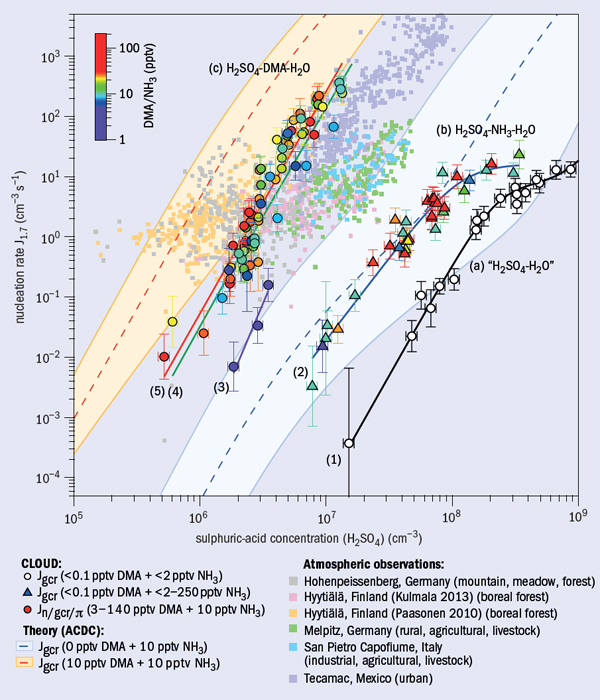
The CLOUD experiment at CERN, which is studying whether cosmic rays have a climatically significant effect on aerosols and clouds, is also tackling one of the most challenging and long-standing problems in atmospheric science – understanding how new aerosol particles are formed in the atmosphere and the effect that these particles have on climate. In a major step forward, the CLOUD collaboration has made the first measurements – either in the laboratory or in the atmosphere – of the formation rates of atmospheric aerosol particles that have been identified with clusters of precisely known molecular composition.
Atmospheric aerosol particles cool the climate by reflecting sunlight and by forming smaller but more numerous cloud droplets, which makes clouds brighter and extends their lifetimes. By current estimates, about half of all cloud drops are formed on aerosol particles that were “nucleated” – that is, produced from the clustering of tiny concentrations of atmospheric molecules rather than being emitted directly into the atmosphere, as happens with sea-spray particles. Nucleation is therefore likely to be a key process in climate regulation. However, the physical mechanisms of nucleation are not understood, nor is it known which molecules participate in nucleation and whether they derive from natural sources or are emitted by human activities.
CLOUD has studied the formation of new atmospheric particles in a specially designed chamber under extremely well controlled laboratory conditions of temperature, humidity and concentrations of nucleating vapours. This chamber is the first to reach the challenging technical requirements on ultra-low levels of contaminants that are necessary to carry out these experiments in the laboratory. Using state-of-the-art instruments that are connected to the chamber, the experiment can measure extremely low concentrations of atmospheric vapours. It can also study the precise molecular make-up and growth of newly formed molecular clusters from single molecules up to stable aerosol particles.
This has enabled CLOUD to measure the formation of particles that are caused by sulphuric acid and tiny concentrations of dimethylamine near the level of 1 molecule per trillon (1012 ) air molecules. The measurements, made at 278 K and 38% relative humidity, involved different combinations of sulphuric acid (H2SO4) and water (H2O), with ammonia (NH3) or dimethylamine (DMA). The figure shows the results from CLOUD together with various atmospheric measurements and theoretical expectations based on quantum chemical calculations of cluster binding energies. The results indicate that amines at typical atmospheric concentrations of only a few parts per trillion by volume combine with sulphuric acid to form highly stable aerosol particles at rates that are similar to those observed in the lower atmosphere. The figure also shows that these highly detailed measurements allow a fundamental understanding of the nucleation process at the molecular level because they can be reproduced by the theoretical calculations of molecular clustering.
Amines are atmospheric vapours that are closely related to ammonia. Derived largely from anthropogenic activities – mainly animal husbandry – they are also emitted by the oceans, the soil and from biomass burning. The results from CLOUD suggest that natural and anthropogenic sources of amines could influence climate. CLOUD has also found that ionization by cosmic rays has only a small effect on the formation rate of amine–sulphuric-acid particles, suggesting that cosmic rays are unimportant for the generation of these particular aerosol particles in the atmosphere.
• The CLOUD collaboration consists of the California Institute of Technology, Carnegie Mellon University, CERN, Finnish Meteorological Institute, Helsinki Institute of Physics, Johann Wolfgang Goethe University Frankfurt, Karlsruhe Institute of Technology, Lebedev Physical Institute, Leibniz Institute for Tropospheric Research, Paul Scherrer Institute, University of Beira Interior, University of Eastern Finland, University of Helsinki, University of Innsbruck, University of Leeds, University of Lisbon, University of Manchester, University of Stockholm and University of Vienna.
Further reading
J Almeida et al. (CLOUD collaboration) 2013 Nature DOI: 10.1038/nature12663.







